[English] 日本語
 Yorodumi
Yorodumi- PDB-5bjt: Crystal structure of human FcRn with a peptide inhibitor at multi... -
+ Open data
Open data
- Basic information
Basic information
| Entry | Database: PDB / ID: 5bjt | ||||||
|---|---|---|---|---|---|---|---|
| Title | Crystal structure of human FcRn with a peptide inhibitor at multiple sites | ||||||
 Components Components |
| ||||||
 Keywords Keywords | IMMUNE SYSTEM/INHIBITOR / immunoglobulin binding protein / cell membrane / disulfide bond / glycoprotein / IgG-binding protein / immunoglobulin domain / receptor / transmembrane / amyloid / amyloidosis / disease mutation / glycation / immune response / MHC I / pyrrolidone carboxylic acid / secreted / IMMUNE SYSTEM-INHIBITOR complex | ||||||
| Function / homology |  Function and homology information Function and homology informationIgG immunoglobulin transcytosis in epithelial cells mediated by FcRn immunoglobulin receptor / IgG binding / beta-2-microglobulin binding / negative regulation of receptor binding / early endosome lumen / Nef mediated downregulation of MHC class I complex cell surface expression / DAP12 interactions / transferrin transport / cellular response to iron ion / Endosomal/Vacuolar pathway ...IgG immunoglobulin transcytosis in epithelial cells mediated by FcRn immunoglobulin receptor / IgG binding / beta-2-microglobulin binding / negative regulation of receptor binding / early endosome lumen / Nef mediated downregulation of MHC class I complex cell surface expression / DAP12 interactions / transferrin transport / cellular response to iron ion / Endosomal/Vacuolar pathway / Antigen Presentation: Folding, assembly and peptide loading of class I MHC / peptide antigen assembly with MHC class II protein complex / cellular response to iron(III) ion / negative regulation of forebrain neuron differentiation / MHC class II protein complex / antigen processing and presentation of exogenous protein antigen via MHC class Ib, TAP-dependent / ER to Golgi transport vesicle membrane / peptide antigen assembly with MHC class I protein complex / regulation of iron ion transport / regulation of erythrocyte differentiation / HFE-transferrin receptor complex / response to molecule of bacterial origin / MHC class I peptide loading complex / T cell mediated cytotoxicity / positive regulation of T cell cytokine production / antigen processing and presentation of endogenous peptide antigen via MHC class I / antigen processing and presentation of exogenous peptide antigen via MHC class II / positive regulation of immune response / MHC class I protein complex / peptide antigen binding / positive regulation of T cell activation / negative regulation of neurogenesis / positive regulation of receptor-mediated endocytosis / cellular response to nicotine / positive regulation of T cell mediated cytotoxicity / multicellular organismal-level iron ion homeostasis / specific granule lumen / phagocytic vesicle membrane / recycling endosome membrane / Interferon gamma signaling / Immunoregulatory interactions between a Lymphoid and a non-Lymphoid cell / negative regulation of epithelial cell proliferation / MHC class II protein complex binding / Modulation by Mtb of host immune system / late endosome membrane / sensory perception of smell / positive regulation of cellular senescence / tertiary granule lumen / DAP12 signaling / T cell differentiation in thymus / negative regulation of neuron projection development / ER-Phagosome pathway / protein refolding / early endosome membrane / protein homotetramerization / amyloid fibril formation / intracellular iron ion homeostasis / learning or memory / endosome membrane / immune response / endoplasmic reticulum lumen / Amyloid fiber formation / Golgi membrane / external side of plasma membrane / lysosomal membrane / focal adhesion / Neutrophil degranulation / SARS-CoV-2 activates/modulates innate and adaptive immune responses / structural molecule activity / endoplasmic reticulum / Golgi apparatus / protein homodimerization activity / extracellular space / extracellular exosome / extracellular region / identical protein binding / membrane / plasma membrane / cytosol Similarity search - Function | ||||||
| Biological species |  Homo sapiens (human) Homo sapiens (human)synthetic construct (others) | ||||||
| Method |  X-RAY DIFFRACTION / X-RAY DIFFRACTION /  SYNCHROTRON / SYNCHROTRON /  MOLECULAR REPLACEMENT / Resolution: 3.2 Å MOLECULAR REPLACEMENT / Resolution: 3.2 Å | ||||||
 Authors Authors | Nienaber, V. / Badger, J. | ||||||
 Citation Citation |  Journal: Proc. Natl. Acad. Sci. U.S.A. / Year: 2017 Journal: Proc. Natl. Acad. Sci. U.S.A. / Year: 2017Title: Hepatic FcRn regulates albumin homeostasis and susceptibility to liver injury. Authors: Pyzik, M. / Rath, T. / Kuo, T.T. / Win, S. / Baker, K. / Hubbard, J.J. / Grenha, R. / Gandhi, A. / Kramer, T.D. / Mezo, A.R. / Taylor, Z.S. / McDonnell, K. / Nienaber, V. / Andersen, J.T. / ...Authors: Pyzik, M. / Rath, T. / Kuo, T.T. / Win, S. / Baker, K. / Hubbard, J.J. / Grenha, R. / Gandhi, A. / Kramer, T.D. / Mezo, A.R. / Taylor, Z.S. / McDonnell, K. / Nienaber, V. / Andersen, J.T. / Mizoguchi, A. / Blumberg, L. / Purohit, S. / Jones, S.D. / Christianson, G. / Lencer, W.I. / Sandlie, I. / Kaplowitz, N. / Roopenian, D.C. / Blumberg, R.S. | ||||||
| History |
|
- Structure visualization
Structure visualization
| Structure viewer | Molecule:  Molmil Molmil Jmol/JSmol Jmol/JSmol |
|---|
- Downloads & links
Downloads & links
- Download
Download
| PDBx/mmCIF format |  5bjt.cif.gz 5bjt.cif.gz | 299.9 KB | Display |  PDBx/mmCIF format PDBx/mmCIF format |
|---|---|---|---|---|
| PDB format |  pdb5bjt.ent.gz pdb5bjt.ent.gz | 235.7 KB | Display |  PDB format PDB format |
| PDBx/mmJSON format |  5bjt.json.gz 5bjt.json.gz | Tree view |  PDBx/mmJSON format PDBx/mmJSON format | |
| Others |  Other downloads Other downloads |
-Validation report
| Summary document |  5bjt_validation.pdf.gz 5bjt_validation.pdf.gz | 537.1 KB | Display |  wwPDB validaton report wwPDB validaton report |
|---|---|---|---|---|
| Full document |  5bjt_full_validation.pdf.gz 5bjt_full_validation.pdf.gz | 614.6 KB | Display | |
| Data in XML |  5bjt_validation.xml.gz 5bjt_validation.xml.gz | 59.5 KB | Display | |
| Data in CIF |  5bjt_validation.cif.gz 5bjt_validation.cif.gz | 81.7 KB | Display | |
| Arichive directory |  https://data.pdbj.org/pub/pdb/validation_reports/bj/5bjt https://data.pdbj.org/pub/pdb/validation_reports/bj/5bjt ftp://data.pdbj.org/pub/pdb/validation_reports/bj/5bjt ftp://data.pdbj.org/pub/pdb/validation_reports/bj/5bjt | HTTPS FTP |
-Related structure data
| Related structure data |  3m17S S: Starting model for refinement |
|---|---|
| Similar structure data |
- Links
Links
- Assembly
Assembly
| Deposited unit | 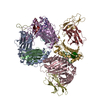
| ||||||||
|---|---|---|---|---|---|---|---|---|---|
| 1 | 
| ||||||||
| 2 | 
| ||||||||
| 3 | 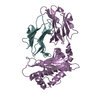
| ||||||||
| 4 | 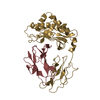
| ||||||||
| 5 | 
| ||||||||
| 6 | 
| ||||||||
| 7 | 
| ||||||||
| 8 | 
| ||||||||
| 9 | 
| ||||||||
| 10 | 
| ||||||||
| 11 | 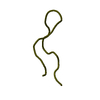
| ||||||||
| Unit cell |
|
- Components
Components
| #1: Protein | Mass: 29720.383 Da / Num. of mol.: 4 / Fragment: extracellular domain (UNP residues 24-290) Source method: isolated from a genetically manipulated source Source: (gene. exp.)  Homo sapiens (human) / Gene: FCGRT, FCRN / Production host: Homo sapiens (human) / Gene: FCGRT, FCRN / Production host:  #2: Protein | Mass: 11748.160 Da / Num. of mol.: 4 / Fragment: UNP residues 21-119 Source method: isolated from a genetically manipulated source Source: (gene. exp.)  Homo sapiens (human) / Gene: B2M, CDABP0092, HDCMA22P / Production host: Homo sapiens (human) / Gene: B2M, CDABP0092, HDCMA22P / Production host:  #3: Protein/peptide | Mass: 2158.483 Da / Num. of mol.: 7 / Source method: obtained synthetically / Source: (synth.) synthetic construct (others) Has protein modification | Y | |
|---|
-Experimental details
-Experiment
| Experiment | Method:  X-RAY DIFFRACTION / Number of used crystals: 1 X-RAY DIFFRACTION / Number of used crystals: 1 |
|---|
- Sample preparation
Sample preparation
| Crystal | Density Matthews: 3.13 Å3/Da / Density % sol: 60.75 % |
|---|---|
| Crystal grow | Temperature: 277 K / Method: vapor diffusion, sitting drop / pH: 4.7 Details: 1.6 M ammonium sulfate, 20% glycerol, 0.8 M sodium acetate |
-Data collection
| Diffraction | Mean temperature: 100 K |
|---|---|
| Diffraction source | Source:  SYNCHROTRON / Site: SYNCHROTRON / Site:  APS APS  / Beamline: 22-BM / Wavelength: 1 Å / Beamline: 22-BM / Wavelength: 1 Å |
| Detector | Type: MARMOSAIC 225 mm CCD / Detector: CCD / Date: Oct 31, 2008 |
| Radiation | Monochromator: double crystal Si(220) / Protocol: SINGLE WAVELENGTH / Monochromatic (M) / Laue (L): M / Scattering type: x-ray |
| Radiation wavelength | Wavelength: 1 Å / Relative weight: 1 |
| Reflection | Resolution: 3.2→50 Å / Num. obs: 37736 / % possible obs: 99.9 % / Observed criterion σ(I): -4 / Redundancy: 5.6 % / Rmerge(I) obs: 0.111 / Net I/σ(I): 16.6 |
| Reflection shell | Resolution: 3.2→3.31 Å / Redundancy: 5.7 % / Rmerge(I) obs: 0.718 / Mean I/σ(I) obs: 2.7 / % possible all: 100 |
- Processing
Processing
| Software |
| ||||||||||||||||||||||||||||||||||||||||||||||||||||||||||||||||||||||||||||||||||||||||||||||||||||||||||||||||||||||||||||||||||||||||||||||||||||||||||||||||||||||||||||||||||||||
|---|---|---|---|---|---|---|---|---|---|---|---|---|---|---|---|---|---|---|---|---|---|---|---|---|---|---|---|---|---|---|---|---|---|---|---|---|---|---|---|---|---|---|---|---|---|---|---|---|---|---|---|---|---|---|---|---|---|---|---|---|---|---|---|---|---|---|---|---|---|---|---|---|---|---|---|---|---|---|---|---|---|---|---|---|---|---|---|---|---|---|---|---|---|---|---|---|---|---|---|---|---|---|---|---|---|---|---|---|---|---|---|---|---|---|---|---|---|---|---|---|---|---|---|---|---|---|---|---|---|---|---|---|---|---|---|---|---|---|---|---|---|---|---|---|---|---|---|---|---|---|---|---|---|---|---|---|---|---|---|---|---|---|---|---|---|---|---|---|---|---|---|---|---|---|---|---|---|---|---|---|---|---|---|
| Refinement | Method to determine structure:  MOLECULAR REPLACEMENT MOLECULAR REPLACEMENTStarting model: PDB entry 3M17 Resolution: 3.2→49.27 Å / Cor.coef. Fo:Fc: 0.879 / Cor.coef. Fo:Fc free: 0.79 / SU B: 29.352 / SU ML: 0.52 / Cross valid method: THROUGHOUT / ESU R Free: 0.624
| ||||||||||||||||||||||||||||||||||||||||||||||||||||||||||||||||||||||||||||||||||||||||||||||||||||||||||||||||||||||||||||||||||||||||||||||||||||||||||||||||||||||||||||||||||||||
| Solvent computation | Ion probe radii: 0.8 Å / Shrinkage radii: 0.8 Å / VDW probe radii: 1.4 Å | ||||||||||||||||||||||||||||||||||||||||||||||||||||||||||||||||||||||||||||||||||||||||||||||||||||||||||||||||||||||||||||||||||||||||||||||||||||||||||||||||||||||||||||||||||||||
| Displacement parameters | Biso mean: 62.17 Å2
| ||||||||||||||||||||||||||||||||||||||||||||||||||||||||||||||||||||||||||||||||||||||||||||||||||||||||||||||||||||||||||||||||||||||||||||||||||||||||||||||||||||||||||||||||||||||
| Refinement step | Cycle: LAST / Resolution: 3.2→49.27 Å
| ||||||||||||||||||||||||||||||||||||||||||||||||||||||||||||||||||||||||||||||||||||||||||||||||||||||||||||||||||||||||||||||||||||||||||||||||||||||||||||||||||||||||||||||||||||||
| Refine LS restraints |
|
 Movie
Movie Controller
Controller


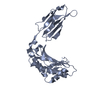
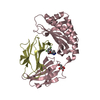

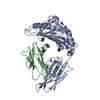

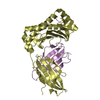
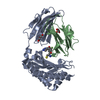

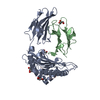

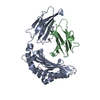
 PDBj
PDBj

